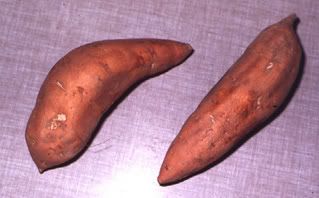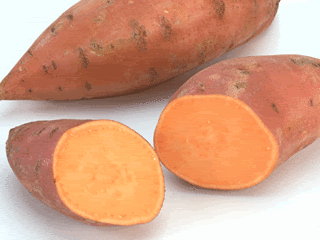The answer: Everything - or nothing at all.
Though sweet potatoes are often called yams in the US, the starchy root vegetables that most consumers buy are actually sweet potatoes, and not yams, which are entirely different plants. Wikipedia clears up the confusion:
"Yams are a monocot (a plant having one embryonic seed leaf) and from the Dioscoreaceae or Yam family. Sweet Potatoes, often called ‘yams’, are a dicot (a plant having two embryonic seed leaves) and are from the Convolvulacea or morning glory family."

Yams.

Sweet potatoes.
How do you tell the difference? Yams are darker-skinned and sweeter than sweet potatoes.
Fun facts:
- Both sweet potatoes and yams grow in tropical climates. Sweet potatoes are native to the Americas; yams are native to Africa and Asia.
- "The word yam comes from African words njam, nyami, or djambi, meaning "to eat," and was first recorded in America in 1676."
- "China is the largest grower of sweet potatoes; providing about 80% of the world's supply."
- "Besides simple starches, sweet potatoes are rich in complex carbohydrates, dietary fiber, beta carotene, vitamin C and vitamin B6."
- "In many societies yams are so important that one can speak of a 'yam culture'. Growing the tuber is associated with magic; the best ones must be given to the chief or king; there is a series of myths connected to a divine origin; a farmer may gain a lot of prestige by growing the largest or longest yam; etc. Here are some examples of where this applies:
In Micronesia, see for example Pohnpei.
In Melanesia, see for example Vanuatu, Papua New Guinea.
In Polynesia (west Polynesia only), see Samoa, Tonga."

2 comments:
actually, yams (as a sweet potato) is supposed to apply only to a specific variety of sweet potato harvested in Louisiana. The alternative name being 'louisiana sweet potato'.
Marc Summers told me this on the food channel network's thanksgiving special.
Good to know. Thanks, Kyl!
Post a Comment